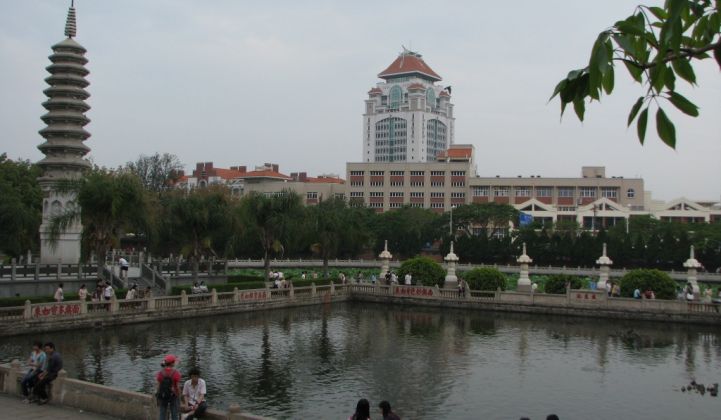Solar panels generate direct current (DC) power, and computers, printers, telephones, lights, and pretty much every other typical office power load use DC power. Why waste energy converting all that power to alternating current (AC) and back again, just to satisfy a century-old convention for how we electrify buildings?
That’s the premise behind a fascinating project underway at China’s Xiamen University that’s using DC power to connect rooftop solar panels to lights, HVAC systems, data centers and plug-in vehicle chargers. Nextek Power Systems is providing the solar-to-building DC power technology, China-based Canadian Solar provides the solar panels, and Palo Alto, Calif.-based startup People Power will provide the cloud-based software platform to connect it to people in the building.
Lawrence Berkeley National Laboratory will provide “algorithms for the optimal equipment choice and operation of direct-current microgrids.” LBNL hosts the U.S.-China Clean Energy Research Center, part of the joint U.S.-Chinese smart grid partnership formed by Energy Secretary Steven Chu in 2009. Intel is providing “technical expertise and advice,” and has been working on DC power research at an Intel Labs energy research facility in New Mexico.
Overall, shifting power loads to DC can improve building energy efficiency by 25 percent to 35 percent, said John Teeter, People Power’s chief scientist. Mainly, that’s achieved by cutting power conversion losses: “We’re looking at a general loss of about 15 percent to 20 percent on each transition” from DC to AC and back again, he said.
That’s a general figure -- next-generation power electronics systems can cut conversion losses down to the low single digits. But direct DC power cuts that down to zero.
Buildings still have to convert DC to different voltages, of course, depending on the application. The EMerge Alliance, a DC building power consortium of big names in the electronics and buildings fields, has set a 380-volt standard for powering data centers, and a 24-volt standard for its “occupied spaces” category, which includes offices and anywhere else people roam freely.
That’s where People Power comes in. The startup, founded by former Bitfone and Computer Motion CEO Gene Wang, has taken a winding path through various smart-energy plans, from building its own chipsets for in-home networked devices to creating the cloud-based software management platform that runs them in unison. It is working with Texas Instruments, Ricoh, Blue Line Innovations and others, though it hasn’t claimed any big deployments yet.
In the case of Xiamen, People Power will run the system that lets people interact with building energy use, setting office cubicles to turn off when they’re not being used, powering data centers up and down to meet IT demand, and the like. The startup wants to embed its operating system in office equipment, lights, power strips and anything else that can connect to the internet.
Data centers have been a major focus for DC building power, with companies like ABB, General Electric and Emerson getting involved. Facebook’s super-efficient Oregon data center runs on DC power, and using LEDs instead of fluorescent lights also benefits from the fact that LEDs run on direct current. As for the solar connection, AMD, HP and others are looking at ways to tap wind and solar power directly to feed servers, though of course, they all need steady backup power to keep humming.
While the Xiamen project isn’t taking on direct-to-the-desktop DC power, the EMerge Alliance has launched a task force to work on the idea of powering computers, printers and other plug-in office gear without those pesky, wasteful converters on every power cord. Of course, that also means switching out all the outlets in the office with a DC equivalent of some kind, which limits its potential as a retrofit technology.
Xiamen, one of China’s main energy technology R&D hubs, plans to outfit three buildings with the technology by summer, Teeter said. Monday’s press release said the work should serve as a “global showcase for distributed direct-current microgrid innovation and commercialization,” with an emphasis on the last word in that sentence.



